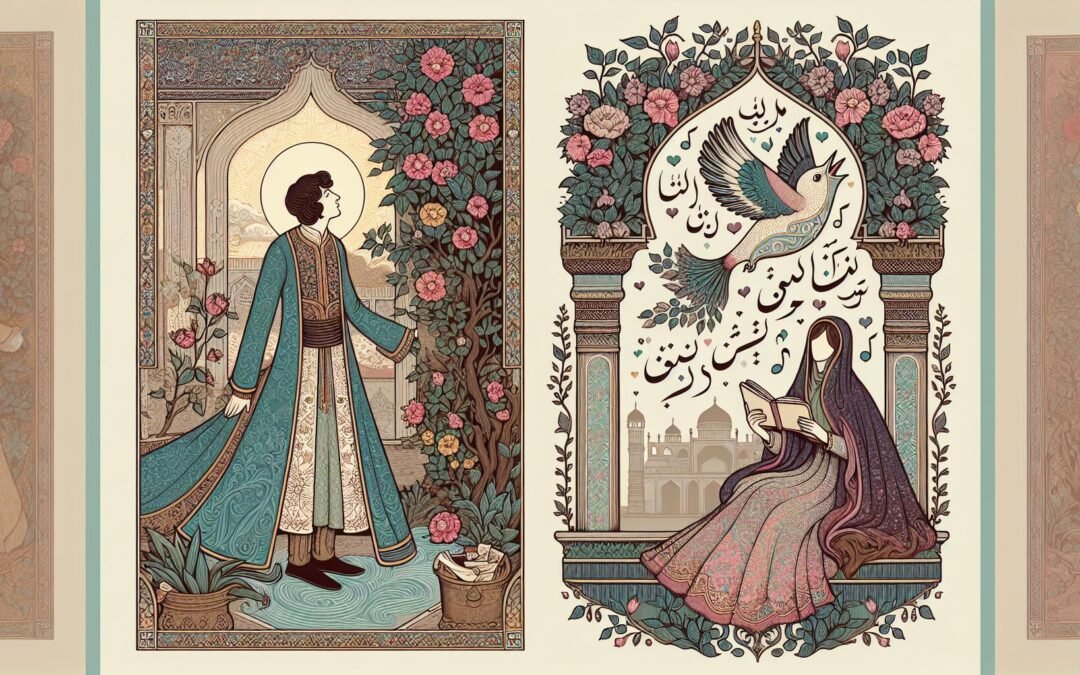Vivid and labyrinthine, Farsi love poetry embodies a centuries-long drama of longing, symbolism, and reinvention. Its foundational gestures unfurl across epics, lyrics, court ritual, and mystical riddles. The classical tradition intertwines passion for a beloved (earthly or divine) with philosophies of absence and union, forging genres unparalleled in compression and emotional velocity. Poets and forms spiral through evolutionary arcs, transforming courtly theater, religious aspiration, and coded selfhood into an enduring legacy that continues to inspire global approaches to rhyming love poetry and explore romantic subtexts in eras far removed from early Iran.
Historical Overview of Farsi Love Poetry
Ancient Iran’s mythic and ritual landscape nurtured seeds of poetic yearning. Achaemenid cuneiform inscriptions and Zoroastrian liturgies reference order, desire, and cosmic beauty, hinting at a lyrical consciousness preceding written verse in Persian. Sassanian Iran, renowned for its intellectual salons and oral artistry, cultivated a tradition where cosmological imagery shadowed secular narratives—priestly wisdom registered alongside royal infatuations. Following the Islamic conquest, the emergence of New Persian poetic expression—inflected by Arabic meters and sensibility—reshaped the terrain. Samanid and early Islamic poets grafted indigenous motifs of longing onto imported grammatical and lexical forms, forging a matrix in which sacred and profane passion coexisted, blurring devotion with erotic lament.
Pre-Islamic and Early Islamic Origins
Surviving relics hint at the region’s ancient literary imagination. Zoroastrian hymns project a longing for order and purity, cloaked in metaphysical allusion. Oral storytelling at Sassanian courts layered spiritual cosmology onto tales of courtly desire, foreshadowing the integration of mystical and romantic themes. After the Arab conquest, Persian poets adapted Arabic genres to local taste, generating an idiom that anchored aspiration and yearning within evolving literary conventions. Within initial Farsi texts, sacred and secular motifs wove together, inaugurating the hybrid character of later types of love poetry across the region.
Evolution Through Major Dynasties
The Samanid dynasty established Persian as a language of prestige, supporting creative experimentation. Rudaki, often acclaimed as patriarch of Persian letters, drew from folk narrative and melody to imbue court poetry with resonant immediacy. Love themes gained urban texture and alignment with prevailing ethical codes, migrating from rustic folklore to sophisticated literary registers. Under the Ghaznavids, poetic commissions multiplied, transforming scenes of heartbreak and admiration into expressions of political rivalry and personal testimony. The Seljuk era formalized the ghazal, setting the lover’s lament and doctrines of beauty to new technical standards. The Timurids, with a taste for intricate metaphor and artistry, sponsored the refinement of lyric forms, prompting increased density of imagery and experimentation across poetic circles. Mongol and post-Safavid political waves introduced novel configurations, enabling new voices and regional perspectives to complicate and energize the Persian poetic map.
Sufism and Courtly Culture
The twelfth century intensified the alignment of poetic love with spiritual aspiration. Sufi thinkers such as Attar harnessed romance and pain as allegories for mystical union. Lyric meditations on desire and alienation became theological inquiry, positioning the beloved as both idol and threshold to the transcendent. Court poets, surrounded by music, wine, and garden revelry, adopted sensorial cues and vivid imagery, fusing corporeal longing with metaphysical ambition. Poetic gatherings at courts and khanqahs celebrated the limits of language, performance, and desire, allowing Sufi and secular traditions to overlap, compete, and cross-pollinate.
Milestones and Literary Movements
The Safavid period energized lyric traditions with new doctrinal undertones; Shi’i imagery, martyrdom, and coded critique flourished in gatherings of poets and connoisseurs. Tazkiras chronicled fresh regional styles and approaches to wooing, from dialectal innovation to experiments with unorthodox metaphors. With the decline of imperial centralization, minor courts and independent authors pursued inventive models, adding heterodox or local color to the prevailing canons. This ferment produced both a broadening palette of eros in verse and new routes for interregional dissemination, enriching other poetic landscapes concerned with cosmic love and longing.
Major Poets and Their Contributions
No account of farsi love poetry can proceed without close attention to the architects of its tradition. Under shifting dynasties and religious climates, the most influential figures adapted forms and motifs to suit evolving social, spiritual, and personal needs.
Rudaki: Architect of Persian Lyricism
Leaning on narrative suspense and the subtlety of colloquial speech, Rudaki animated Persian court poetry with immediacy and emotional ambiguity. His surviving fragments encode desire both as praise and longing, sketching boundaries for lyric forms to flourish and multiply.
Ferdowsi and Epic Infusions
Ferdowsi’s monumental Shahnameh merges vast mythological arcs with sharp moments of romantic drama. Tales of Zal and Rudaba or Bijan and Manijeh channel longing into broader explorations of fate and loyalty. Through his epic, love assumes archetypal stature, influencing the themes of subsequent lyricists. Connections with legendary romance in romantic poems continue to echo his approach.
Omar Khayyam: The Rubaiyat’s Epistemic Provocations
Omar Khayyam employs the rubaiyat stanza to question boundaries of knowledge, certainty, and pleasure. Within crystalline quatrains, the beloved and wine intermingle, casting romantic and philosophical quandaries into fleeting, paradoxical clarity. Sensual imagery operates on multiple planes, inviting readings that traverse carpe diem, skepticism, and yearning.
Attar and the Sufi Parable
With Attar, mystical allegory finds dramatic force. His Conference of the Birds models desire as a spiritual engine, using tales of separation and longing to chronicle the seeker’s journey toward insight. The line between lover and beloved blurs; agony morphs into transformative insight.
Rumi: Architect of Mystic Ecstasy
Rumi revolutionized Persian verse by entangling sensory attraction with mystical aspiration. Paradox fuels his lyricism: presence manifests through longing, unity emerges from absence. His poetry articulates transitions between the personal and universal, fostering fluid subjectivities and reframing separation as the ground of union. Rumi’s intensity has shaped not only Persianate traditions but wide-ranging currents of most romantic poems of all time.
Sa’di: Social Registers of Affection
In Sa’di’s Gulistan and Bustan, love and friendship are tested through stories of generosity, irony, and wisdom. His observations on power, servitude, and gender interrogate social relations while remaining rooted in the poetics of attraction. Sa’di’s works shape the ethics and performance of affection, advancing themes of transformation and resilience.
Hafez: Polyphony and Hermeneutic Multiplicity
Hafez’s ghazals radiate ambiguity. His beloved flickers across registers—divine, political, embodied, literary—while garden, wine, and desire motifs foster interpretive layering. With his playful ironies and cryptic gestures, Hafez transforms familiar images into sites for subtle defiance and aspiration. Hermeneutic multiplicity becomes central, as readings evolve and amplify new dimensions of devotion, rebellion, or surrender.
Jami: Late Medieval Experimentalism
Jami operates at the intersection of narrative sweep and Sufi complexity. In Yusuf and Zuleikha, devotional love yields to spiritual allegory, yet tension and beauty retain narrative intensity. Jami’s style and synthesis seed further innovation beyond Iranian borders, nourishing poetic voices throughout South and Central Asia.
Forms and Structures in Farsi Love Poetry
Genres, metrical systems, and symbolic repertoires fuel the protean nature of Persian verse. Every form forges new paths for articulating longing, revelation, and disguise, while technical ingenuity spawns schools and experiments perpetually reshaping the canon.
Ghazal: Modular Lyric Intensity
The ghazal develops through semi-independent couplets, activating suspense through repetition of rhyme and radif. Thematic unity springs from semantic fields or recurring imagery, with fragmentation valorized alongside suggestion. This design enables compact emotional arcs, quick turns of address, or oblique statement, supporting linguistic play and interpretive freedom. Ghazals have influenced global traditions eager to balance structure with expressive risk, as seen in contemporary explorations of best love poetry books.
Constructed through seamless pairs of rhymed lines, the masnavi expands poetic scope from lyric flash to extended narrative. Masnavis range from dramas of unrequited romance to epics of mystical quest, encompassing allegory and psychological study. Didactic and ornamental possibilities coexist, enabling stylized storytelling and ethical subtlety to flourish together.
Qasida and Rubaiyat
Qasidas, historically associated with praise and panegyric, evolve as carriers of concealed longing. Strategic addition of longing transforms epistolary or panegyric surfaces into mediums for personal confession and sly dissent. Rubaiyat compress complexity into quatrain architecture, fusing contradiction and insight into striking conclusion. These forms accommodate meta-commentary, reversal, and epigram—a style that continues to impact international traditions and analytical frameworks found in reflection on metaphors in poetry.
Metrical Schemes and Symbolic Devices
Classical Persian poetry is founded on quantitative meters, orchestrating interplay of short and long syllables with precision. Patterns arise that encode musicality, enabling oral and written recitation to reinforce memory and improvisation. Symbolism—roses, nightingales, cypress, wine—serves both as direct representation and cryptic signal. These motifs invite endless recombination; the rose may gesture to divine brilliance, carnal delight, or rhetorical flourish, depending on context and reader.
Themes and Motifs
Motivic density and thematic recursion drive the tradition’s enduring resonance. The movement between corporeal and transcendental, accessible and unattainable, gives the poetry shape and urgency.
Divine and Earthly Axes of Love
Carnal delight intertwines with celestial aspiration, dissolving dogmatic binaries. Sufi lyricism frames love’s dynamism as privation or glory, recasting disappointment as illumination. Verses encode theological depth within worldly complaint, refracting sacred longing through the immediacy of attraction. The fusion of registers imparts Persian love traditions with interpretive wealth sometimes mirrored in approaches described in infidelity in poetry and other global canons.
Unattainable Beloved and Longing
Images of remote or unyielding beloveds animate endless refrain. Fulfillment recedes, replaced by states of waiting, absence, and utterance. The tension between nearness and separation generates an inexhaustible poetic engine; the liminal becomes creative ground, with delay or silence transformed into generative space.
Mysticism and the Sufi Concept of Love
Divine and human longing converge through paradox and metaphor. The seeker’s journey is cast in terms of fire, moth, candle—a drama of annihilation and survival. Erotic diction serves as cipher for principles of loss, surrender, and ultimacy. Enigmatic layering supports interpretive multiplicity, aligning spiritual quest with romantic agony.
Nature Imagery and Metaphorical Density
Nature, far beyond ornament, structures emotional experience and poetic order. The beloved’s cheek, stature, gait are rendered as rose, cypress, or moon. Through successive generations, poets recode flora and fauna, producing shifting landscapes that navigate interiority and cosmic schema. Such versatility underscores the function of metaphor both as ornament and epistemic strategy.
Voice, Gender, and Identity of the Beloved
Vocative practice in Persian lyricism enables radical ambiguity of address. The lyric “I” and its beloved traverse registers—homoerotic, female, spiritual—according to poetic whim or constraint. This multivalence provides camouflage and invention alike, cultivating interpretive openness while navigating social risk. Gender, identity, and authorial presence mutate across time, fostering fresh readings and dynamic self-representation inside Persian poetry’s immense archive.

